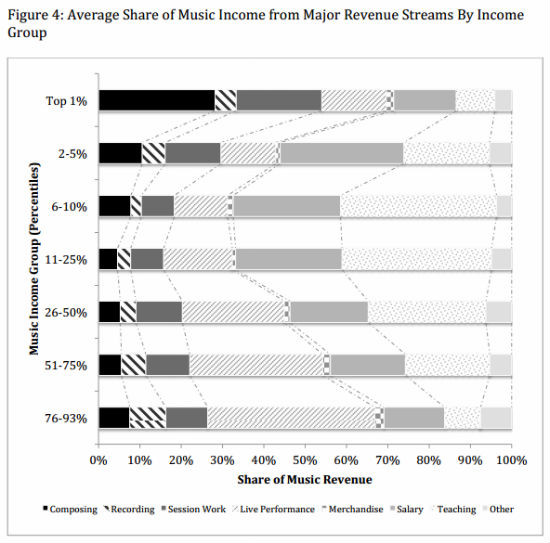For the major music labels the sales of recorded music represent the majority of their revenue, but a different picture emerges when looking at the income of individual musicians. A new survey among 5,000 U.S. musicians of different genres shows that on average only six percent of all revenue comes from recorded music. The research concludes that copyright law mostly affects the revenue of the highest-income musicians in a direct fashion.
The RIAA is certain, piracy has a devastating impact on the music industry.
However, a comprehensive study by Professor Peter DiCola of the Northwestern University School of Law shows that musicians themselves are divided on the subject. The survey questioned more than 5,000 United States artists on a variety of subjects, including unauthorized file-sharing.
Of all artists about a quarter say that they are hurt by online file-sharing, but just as many believe that file-sharing helps them. The remaining half have no opinion on the matter or didn’t answer the question.
The survey further shows that even if file-sharing results in a decrease in sales, this only impacts a small fraction of their total revenue. The pie chart below shows the income sources of musicians, and their average percentages of the total music related revenue.
The pie chart shows that “only” 6 percent of the average musician’s income comes from recorded sales. The revenue from live performances is significantly larger with 28 percent. This last group is also growing rapidly, as previous research has shown.
Average revenue streams

For the major record labels the above pie chart would look quite different, as they mostly rely on revenue from music sales. This also explains their strong views against unauthorized file-sharing.
The survey also collected data on the incomes of the participating musicians. This makes it possible to compare the revenue streams per income group. As can be seen below, recorded sales are below 10 percent for all groups. Interestingly, the lowest income bracket earns relatively the most (9%) from recorded sales.
The top bracket, earning an average $330,000 a year, earns by far the most from compositions, which make up 28 percent of their music-related revenue. The lowest income bracket makes most revenue from live performances, more than 40% .
Revenue streams by income

One of the conclusions of Professor Peter DiCola draws from the results is that copyright law mostly benefits the high earners.
“Rather than providing marginal incentives to create to all musicians at all times, copyright law mostly affects the revenue of the highest-income musicians in a direct fashion. This is not a surprise, given the prevalence of winner-take-all markets in the entertainment industry,” he writes.
However, he doesn’t say that copyright law should be thrown overboard. One reason for this is that the averages reported in the study don’t mean that certain subgroups (such as composers) rely heavily on copyright.
“Musical creativity takes a number of forms, not just the kinds that copyright law protects. This broader perspective should not, however, obscure the reliance on copyright for many musicians in particular subgroups”.
“Those who focus their activity on composing rely on composition revenue and are much more vulnerable to harm from copyright infringement. The same goes for recording artists who rely on sales of sound recordings,” DiCola writes.
There is little doubt that the music industry has undergone drastic change, so it will be interesting to see how these percentages are affected in the coming years.
Update: The title of the article initially didn’t take into account that some composers/songwriters also earn money directly from “music sales.” The 6% only applies to music sales revenue generated from sound recording.
No comments:
Post a Comment